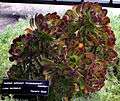Aeonium
Aeonium, the tree houseleeks, is a genus of about 35 species of succulent, subtropical plants of the family Crassulaceae. Many species are popular in horticulture. The genus name comes from the ancient Greek "aionos" (ageless).[1] While most of them are native to the Canary Islands, some are found in Madeira, Morocco, and in East Africa (for example in the Semien Mountains of Ethiopia).
| Aeonium | |
|---|---|
| Saucer-plant (Aeonium undulatum) | |
| Scientific classification | |
| Kingdom: | Plantae |
| Clade: | Tracheophytes |
| Clade: | Angiosperms |
| Clade: | Eudicots |
| Order: | Saxifragales |
| Family: | Crassulaceae |
| Subfamily: | Sempervivoideae |
| Tribe: | Aeonieae |
| Genus: | Aeonium Webb & Berthel. |
| Species | |
|
About 35, see text | |
Description
The succulent leaves are typically arranged on a basal stem, in a dense, spreading rosette. A feature which distinguishes this genus from many of its relatives is the manner in which the flowers bear free petals, and are divided into 6 or 12 sections. Each rosette produces a central inflorescence only once, and then dies back (though it will usually branch or offset to produce ensuing rosettes).
Low-growing Aeonium species are A. tabuliforme and A. smithii; large species include A. arboreum, A. valverdense and A. holochrysum. They are related to the genera Sempervivum, Aichryson and Monanthes, as can be seen by their similar flower and inflorescences. Recently, the genus Greenovia has been placed within Aeonium.
Much hybridising has been done, resulting in several cultivars of mixed or unknown parentage. The following species and cultivars have gained the Royal Horticultural Society’s Award of Garden Merit:-
Distribution
Most aeoniums are from the Canary Islands,[8]:160–173 but some are from Madeira, Morocco and East Africa (Ethiopia, Somalia, Uganda, Tanzania and Kenya) and Yemen.[9]
Some species have been introduced in California.[10]
Selected species
- Aeonium aizoon
- Aeonium appendiculatum
- Aeonium arboreum
- Aeonium aureum
- Aeonium balsamiferum
- Aeonium canariense
- Aeonium castello-paivae
- Aeonium ciliatum
- Aeonium cuneatum
- Aeonium davidbramwellii
- Aeonium decorum
- Aeonium glandulosum
- Aeonium glutinosum
- Aeonium gomerense
- Aeonium gorgoneum
- Aeonium goochiae
- Aeonium haworthii
- Aeonium hierrense
- Aeonium leucoblepharum
- Aeonium lindleyi
- Aeonium nobile
- Aeonium sedifolium
- Aeonium simsii
- Aeonium smithii
- Aeonium spathulatum
- Aeonium tabuliforme
- Aeonium undulatum – saucer plant
- Aeonium urbicum
- Aeonium valverdense
Images
.jpg) Aeonium tabuliforme bearing inflorescence
Aeonium tabuliforme bearing inflorescence Detail of Aeonium tabuliforme flower
Detail of Aeonium tabuliforme flower Aeonium arboreum 'Atropurpureum'
Aeonium arboreum 'Atropurpureum'_(Marianne_Perdomo)_1.jpg) Aeonium aureum
Aeonium aureum Aeonium castello-paivae
Aeonium castello-paivae- Aeonium decorum
- Aeonium lindleyi
 Aeonium nobile
Aeonium nobile- Aeonium simsii
 Aeonium tabuliforme
Aeonium tabuliforme Aeonium tabuliforme × arboreum 'Zwartkop' #2
Aeonium tabuliforme × arboreum 'Zwartkop' #2- Aeonium undulatum
 Aeonium valverdense
Aeonium valverdense
References
- Eggli, U.; Newton, L.E. (2004). Etymological Dictionary of Succulent Plant Names. Springer Berlin Heidelberg. p. 3. ISBN 978-3-540-00489-9. Retrieved 25 September 2018.
- "Aeonium tabuliforme". RHS. Retrieved 27 February 2020.
- "Aeonium haworthii". RHS. Retrieved 27 February 2020.
- "Aeonium haworthii 'Variegatum'". RHS. Retrieved 27 February 2020.
- "Aeonium 'Blushing Beauty'". RHS. Retrieved 27 February 2020.
- "Aeonium 'Sunburst'". RHS. Retrieved 27 February 2020.
- "Aeonium 'Zwartkop'". RHS. Retrieved 27 February 2020.
- Bramwell, D.; Bramwell, Z. (2001). Wild flowers of the Canary Islands. Madrid, Spain: Editorial Rueda. ISBN 84-7207-129-4.
- "International Crassulaceae Network: Aeonium". International Crassulaceae Network. Retrieved 19 February 2017.
- "Aeonium in Flora of North America @ efloras.org". www.efloras.org. Retrieved 2016-10-15.
- R. Nyffeler, "Aeonium", in Urs Eggli, ed. Illustrated Handbook of Succulent Plants: Crassulaceae (Springer, 2003) ISBN 3-540-41965-9
| Wikimedia Commons has media related to Aeonium. |
| Wikispecies has information related to Aeonium |